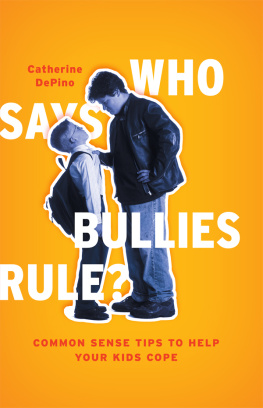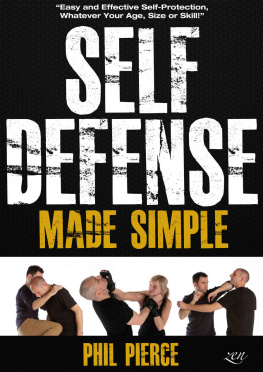SPECIAL ACKNOWLEDGMENTS
Special thanks are due to my father, Michael DePasquale, Sr. for his knowledge and help in the crime prevention and self-defense areas. I would also like to thank my staff, who helped make this book possible, Melissa E. Kisla (Missy), Gail Miller, Dotty Pillischer, Monica Schulman, Eileen Muenchen, James Chin and Roger Chan. I would also like to thank James Kneisler for his photography, Mark Piano, Myron King and Ed Salter for art direction and illustration.
Models appearing in this book include: Bonnie & David Young, Noemi, Vincent Vicente & Jose Manuel Lim, Kevin & Sue Bull, James P. & James P. ll Kneisler, Anna (Cookie) and Mark Guterrez, Gregory Denis, and Jeff Walensky, and Lorie & Nicole Gregory.
A special thanks to Crime Prevention Consultants and Security Experts: Bill DUrso, Robert Suggs, Richard Dillon, Rick Fike, Michael DePasquale, Sr., and Tom Patire for their assistance.
GENERAL ACKNOWLEDGMENTS
It would be very difficult for us to identify all of the sources of the crime prevention and self-defense information used to create this book, but we would like to thank those departments, organizations and reference books that helped make this publication an actuality:
The New York City Police Department
United States Department of Justice
The Federal Bureau of Investigation
National Criminal of Justice Information and
Statistic Service
International Protection Inc.
Interdome Group Inc.
State of the Art Security
The Truth About Self Protection
How to Protect Yourself From Crime
How to Keep From Being Robbed Raped & Ripped Off
Total Self-Protection
Streetwise Safety
for Children
by Robert c. Suggs, Ph.D.
FUMA Crusade Against Crime Coordinator
Groups of high school students lie in wait for students of Elementary School X, at bus stops and along walking routes, attempting to sell the children drugs and threatening them if they do not make purchases. A couple of determined little girls turn the dealers over to police and then live in fear of retaliation for weeks.
A cool youth tall, well-dressed, and a role model in his own mind, attends Elementary School Y. In his school bag he carries a knife, to awe his school mates; a couple of condoms, to hand out to friends; and a wine cooler for lunch, to help reduce the terrible anguish imposed by mental challenge. A year later, before finishing 6th grade, he has been incarcerated for a lengthy term on assault and battery, but his place has been taken by imitators.
In a fight over turf between drug dealers at an upper-middle class high school, students bring guns to school in preparation for a shoot-out. A youth sees a fellow student hide a gun in his locker; he is threatened with death if he reports the presence of the weapon, but does so anyway. Although the threat is never carried out he and his parents remain fearful for his life.
Drug dealers at a suburban high school dress ostentatiously in expensive preppy clothing, attend rock concerts and raves, drive good cars, and openly brag about the amounts of money they make in their business, despite the constant presence of police patrols, who appear totally ignorant of their activities.
A well-known high school football star is arrested for the armed robbery of a group of friends in a local fast food establishment. For the school administration the only important question raised by his act is: should he be allowed to play in the first game of the season?
A group of upper middle class teenagers get drunk on New Years Eve and decide to torchthe local high school, causing $3 million in damages and resulting in the suspension of all school operations for over a year. One parent claims that this act was a legitimate free-speech protest against a repressive school regime which failed to provide an indoor smoking area for the arsonists!
Members of a ring of elderly homosexual child abusers and pornographers linked regional-and national by E-mailhang out at shopping malls attracting young men with promises of gifts and money. They are apprehended and convicted, but refuse to divulge the fate of one of their victims, who has disappeared without a trace.
A class of 4th and 5th grade karate students is being briefed on a serial rapist known by police to be operating in the vicinity of their school. The instructor finishes his presentation, and students hands begin to go up. Within a few minutes, 4 out of 5 of the girls in the class have told their classmates of male relatives and family friends sexual predators who their parents have warned them to avoid!
In an anti-abuse training session, a martial arts instructor gives suggestions on how to cope with threatening adult behaviors. From the back row comes the plaintive question: What do you do when the person bothering you is your father?
THE SITUATION
These few relatively commonplace examples from only one persons experience and knowledge illustrate the increasingly vicious world surrounding a large percentage of American children today, and the apparent inability of authorities to cope with this situation. The schools, the streets, the shopping malls, and even the once sacrosanct home, abound with threats to our nations most important resource our children. Law enforcement seems to be blind, or hobbled by courts, and standards of right and wrong seem infinitely negotiable. There is no indication that this world is going to miraculously change for the better at any time soon!
CRIME STATISTICS
Examples similar to those above, and worse, are everywhere. The real magnitude of the problem is unfortunately quite difficult to estimate, because of numerous problems with crime statistics produced by government, academic, and advocacy groups. These problems result to a large degree from inaccurate or incomplete reporting. It is estimated, for example, that 46% of all violent crimes, 44% of all rapes, and 36% of all crimes are never reported (and these estimates may not be valid either!). Further, there are differences between the ways that states define and report various kinds of crimes that make them difficult to summarize. There is also a tendency not to collect data on crimes committed by members of lower age groups (e.g., below age 12), in which children and youths are victims or perpetrators. There is also the lamentable tendency for all federal statistics to be intentionally altered to support requests for increased departmental funding, or to support the political agenda of political parties or administrations. This tendency is matched by non-government advocacy groups practices of grossly exaggerating the frequency of certain types of crimes to justify their own existence as advocates. Data on missing children, for example, gives the impression that these children are all victims of unknown kidnappers, when, in fact, many have gone willingly with family members fighting custody battles in increasingly capricious courts, or are voluntary runaways. Statistics summarized at national, state, or local levels also blur significant differences in types and frequencies of crimes between states or cities and their suburbs.
Finally, while over 50% of reported cases of child abuse cannot be substantiated, there is also anecdotal evidence of an opposing tendency for some of the worst kinds of child abuse to be underreported; for example sexual abuse of children, which often involves family members and carries a high degree of public disapproval. In such areas, statistics may show only the tip of the iceberg due to reluctance of children to report such crimes and the unwillingness of child advocates to run the risk of serious legal retaliation by defendants if complaints of abuse cannot be fully substantiated.
THE PREVALENCE OF CRIME
Lets examine some of the more reliable information available from various sources, to sketch the dimensions of the problem of child safety.






